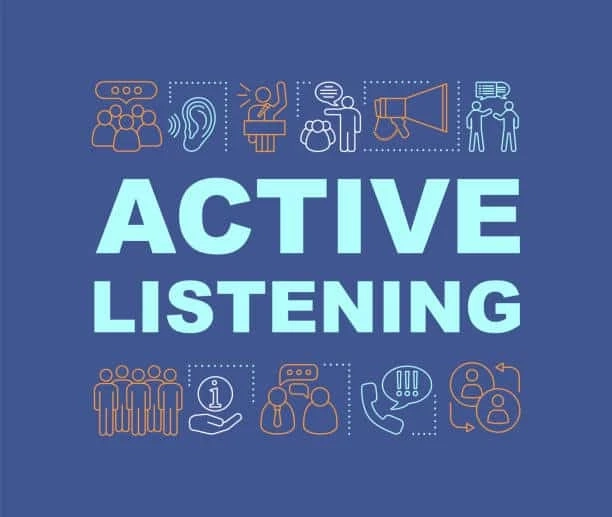In the intricate dance of human interaction, communication stands as the backbone of connection and understanding. Within the vast spectrum of communication skills, active listening emerges as a linchpin, weaving together threads of empathy, comprehension, and engagement. In this exploration, we venture into the symbiotic relationship between active listening and communication, unraveling their nuances, significance, and the transformative impact they wield in various facets of our lives.
The Essence of Active Listening
Defining Active Listening
At its core, active listening is not a passive act of hearing but an intentional and engaged effort to understand the speaker deeply. It involves the full spectrum of senses—listening to words, interpreting tone, observing body language, and acknowledging emotions.
Presence as the Foundation
The foundation of active listening is presence. Being fully present in the moment, devoid of distractions, allows the listener to immerse themselves in the speaker\'s narrative. This creates an atmosphere of mutual respect and fosters a genuine exchange of ideas.
The Dance of Communication: Active Listening in Action
Empathy in Active Listening
Empathy is the heartbeat of active listening. It goes beyond understanding words; it involves connecting with the emotions embedded in the speaker\'s message. When listeners empathize, they create a space where individuals feel seen and heard, fostering a deeper connection.
Non-Verbal Communication and Active Listening
While words form the structure of communication, non-verbal cues provide the color and nuance. Active listening extends beyond verbal expressions to encompass body language, facial expressions, and gestures, adding layers of meaning to the conversation.
Communication as a Two-Way Street
Mutual Understanding through Active Listening
Communication is a reciprocal process, and active listening facilitates a two-way street of understanding. By actively engaging with the speaker, the listener not only comprehends the message but also contributes to the richness of the exchange.
Navigating Misunderstandings
Misunderstandings are inevitable in communication, but active listening serves as a compass for resolution. When faced with discrepancies, active listening allows individuals to seek clarification, identify common ground, and navigate through potential conflicts.
Applications in Personal and Professional Arenas
Active Listening in Personal Relationships
In personal relationships, active listening fosters intimacy and connection. Partners who actively listen create a space where each person feels valued, leading to stronger bonds and a supportive emotional environment.
Active Listening in Professional Settings
In the professional realm, active listening is a catalyst for success. Effective leadership, teamwork, and conflict resolution are all grounded in the ability to actively listen. It enhances collaboration, innovation, and overall workplace dynamics.
The Cognitive Dimensions of Active Listening
Cognitive Load and Active Listening
Active listening involves the management of cognitive load—the mental effort required to process information. Understanding how cognitive load impacts active listening helps individuals navigate complex conversations more effectively.
Memory and Active Listening
Active listening contributes to memory consolidation. When individuals are actively engaged in listening, they are more likely to retain and recall information, making it a valuable tool in educational and professional contexts.
Challenges and Solutions in Active Listening
Cultural Sensitivity in Active Listening
In diverse settings, cultural nuances play a significant role in communication. Active listening requires cultural sensitivity—being attuned to verbal and non-verbal cues that may vary across different cultures.
Overcoming Digital Communication Challenges
As digital communication becomes increasingly prevalent, adapting active listening to virtual platforms is crucial. Techniques such as video conferencing, mindful typing, and utilizing features like emojis become essential in maintaining the essence of active listening.
Active Listening in Conflict Resolution
Turning Conflict into Opportunity
Conflicts are inherent in human interactions, but active listening transforms them from roadblocks to opportunities for understanding. When individuals actively listen during conflicts, they gain insights into each other\'s perspectives, paving the way for resolution.
Empathetic Communication in Tense Situations
Active listening in high-stakes situations involves maintaining empathy even when emotions run high. By acknowledging emotions and actively listening to concerns, individuals can de-escalate tension and work towards constructive solutions.
Educational Frontiers: Active Listening in Learning Environments
Active Listening in Teaching and Learning
Educators who incorporate active listening into their teaching practices create an environment conducive to learning. Students who feel heard and understood are more likely to engage, ask questions, and actively participate in the learning process.
Active Listening as a Lifelong Learning Skill
Beyond formal education, active listening becomes a lifelong learning skill. In an era of constant information flow, individuals who actively listen are better equipped to absorb new ideas, adapt to changes, and continue evolving throughout their lives.
Technological Evolution: Active Listening in the Digital Age
AI Integration and Active Listening
As Artificial Intelligence (AI) evolves, integrating active listening capabilities becomes a frontier. AI-driven tools, from virtual assistants to language processing algorithms, are designed to simulate active listening, raising ethical considerations and opportunities for innovation.
Preserving Human Connection in a Digital World
While technology advances, preserving the essence of human connection is paramount. Active listening becomes a bridge in digital communication, ensuring that even in virtual interactions, individuals feel genuinely heard and understood.
A Future Grounded in Active Listening
Educational Initiatives for Active Listening
Recognizing the transformative power of active listening, educational initiatives can play a crucial role. Incorporating active listening skills into school curricula and workplace training programs fosters a culture where effective communication is valued and practiced.
The Role of Leaders in Promoting Active Listening
Leaders, as influencers and role models, play a pivotal role in promoting active listening within organizations. When leaders prioritize and exemplify active listening, it sets a standard that permeates through teams, departments, and the entire organizational culture.
Conclusion: A Harmonious Tapestry of Connection
In conclusion, active listening techniques are inseparable companions in the journey of human connection. The depth of understanding achieved through active listening enriches every conversation, be it personal or professional. As we navigate the complex landscape of relationships, conflicts, and innovations, the art of active listening serves as a guiding light, illuminating the path toward a more empathetic, collaborative, and interconnected world. Let us continue to embrace the symphony of active listening and communication, recognizing its transformative power to create a harmonious tapestry of understanding in the fabric of our lives.



